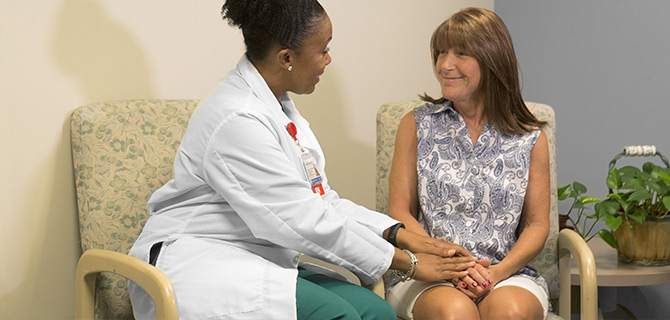Click here for the Radiation Oncology brochure in PDF file format. To view the patient guide file Adobe Reader must be installed on your computer. Adobe Reader is a free program that can be downloaded from www.adobe.com
General Questions
- What is Radiation Oncology?
- How does radiation work?
- Will I become radioactive during my treatment?
- What are the side effects?
- What is the usual routine for radiation therapy treatments?
Radiation Oncology is a medical and oncological discipline that studies the origin and nature of cancer, research, and develop how to treat cancer by using different kinds of radiation in the treatment of various diseases. X-rays, gamma rays, and electrons are commonly used. Each is produced by different kinds of equipment, but all of them are used to destroy abnormal cells while preserving the normal, surrounding tissue.
In many cases, radiation therapy is the single best method for the treatment of diseases such as cancer, but it may also be combined with surgery and/or chemotherapy. At Stony Brook Medicine, most of our treatments are given with x-rays and electron beams generated by machines called linear accelerators. These machines are located in the main hospital in specially shielded areas to protect both the patients and staff during the treatment program.
Providing radiation therapy is a team effort. The team is headed by radiation oncologists (physicians specializing in radiation oncology) who are assisted by radiation oncology nurses, medical physicists, radiation therapists, dosimetrists, nutritionists and social workers. Each team member is trained, certified or licensed as a specialist.
The way radiation cures the tumor is very complex. Simply speaking, when the radiation enters your body, it is absorbed by both normal and abnormal cells. It damages cancer cells by breaking up the DNA strands in the nucleus of the cell. If sufficient damage is inflicted to the cancer cell, then the cell cannot continue to grow and reproduce, and usually dies. Normal body cells are also damaged by radiation. However, usually, a smaller proportion of them are so affected, and normal cells are more capable of repairing radiation damage. The goal of your radiation therapy team is to minimize any unnecessary damage to your healthy cells, while successfully eradicating the malignant cells. By using high-technology treatment with modern equipment, such side effects are not usually seen anymore.
Will I become radioactive during my treatment?
With radiation therapy, you will not become radioactive. You can interact with friends and family members in a normal manner immediately after you leave the department.
If you undergo some forms of brachytherapy and intravenous or oral radioisotope therap[y, you will be advised about any restrictions regarding friends and family. Specific instruction will be given in these situations.
While undergoing radiation, the symptoms of cancer are often relieved and you will actually feel better. However, you may experience certain side effects. These will depend on the part of your body being treated, the amount of radiation you are given, and your body's individual response. It is important to keep in mind that most side effects can be controlled with medication, diet and other appropriate measures. Most people receiving therapy lead normal lives and can continue work during their treatment. Most of the side effects from your treatments will gradually diminish within a few weeks after therapy has been completed. Patients may experience some degree of fatigue during the course of their treatments. This may persist for a few weeks after the end of the therapy which will gradually disappear. Before your treatment begins, the radiation oncologist and the nurse will discuss what other possible side effects, if any, might occur and what measures you can take to control or relieve them. They are also available every day to evaluate any side effects you may be having or to answer any questions you have.
What is the usual routine for radiation therapy treatments?
First, always be sure to check-in at the main reception desk. Our receptionist will check you into our computer system which notifies your radiation therapist of your arrival for treatment. While at the reception desk you may validate your parking ticket or wait until after treatment at the waiting area. Due to the seating limitations and Covid precaution we limit the number of the accompanying family unless their assistance is needed.
Within the waiting room, there are changing rooms with a supply of patient gowns and cubbyholes for clothing and personal articles outside. Not all patients need to wear gowns. Your radiation therapists will tell you whether or not to change into a gown for treatment. For some treatments, just wearing loose clothing that can be opened or moved easily is sufficient. Clothing items should be left in a cubbyhole after changing. Valuables should not be left in the changing room or cubbyholes. When possible, please leave your purse or wallet with a friend or family member prior to beginning each treatment. Currently, the Radiation Oncology Department has 6 radiation therapy treatment rooms. Depending on the types of treatments you will be scheduled a specific time slot for treatment.
Your first visit is usually longer while the radiation therapist performs the initial treatment setup and verifies all information prior to your first treatment. On almost every treatment session, it is performed by image-guided radiotherapy (IGRT) for accurate visualization of the tumor location.
Once a week or every five treatments you will see your radiation oncologist after you check-in, and either prior to or after your treatment. This allows your radiation oncologist and nurse to see how well you are tolerating your treatments and to answer any questions you may have. If at any time you have a question for your radiation oncologist you can always let our staff know or call.


